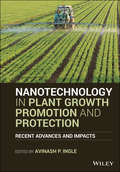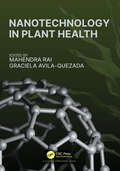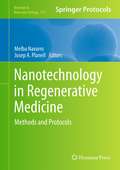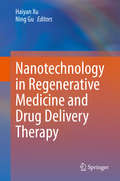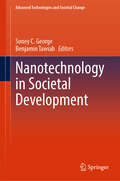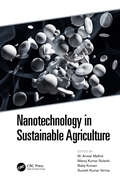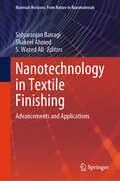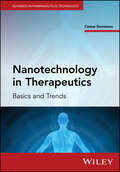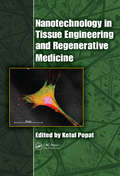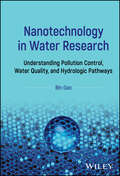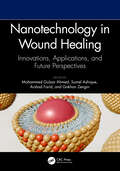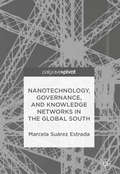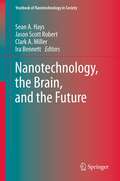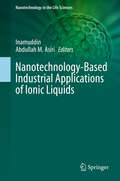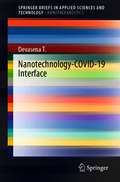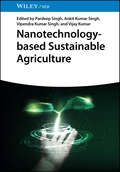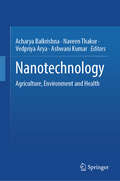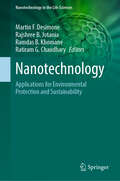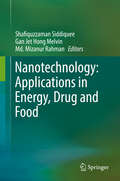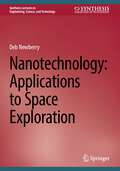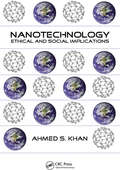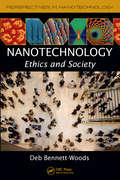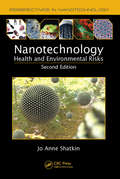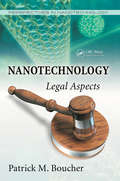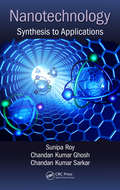- Table View
- List View
Nanotechnology in Plant Growth Promotion and Protection: Recent Advances and Impacts
by Avinash P. IngleDiscover the role of nanotechnology in promoting plant growth and protection through the management of microbial pathogens In Nanotechnology in Plant Growth Promotion and Protection, distinguished researcher and author Dr. Avinash P. Ingle delivers a rigorous and insightful collection of some of the latest developments in nanotechnology particularly related to plant growth promotion and protection. The book focuses broadly on the role played by nanotechnology in growth promotion of plants and their protection through the management of different microbial pathogens. You’ll learn about a wide variety of topics, including the role of nanomaterials in sustainable agriculture, how nano-fertilizers behave as soil feed, and the dual role of nanoparticles in plant growth promotion and phytopathogen management. You’ll also discover why nanotechnology has the potential to revolutionize the current agricultural landscape through the development of nano-based products, like plant growth promoters, nano-fertilizers, nano-pesticides, and nano-insecticides. Find out why nano-based products promise to be a cost-effective, economically viable, and eco-friendly approach to tackling some of the most intractable problems in agriculture today. You’ll also benefit from the inclusion of: A thorough introduction to the prospects and impacts of using nanotechnology to promote the growth of plants and control plant diseases An exploration of the effects of titanium dioxide nanomaterials on plant growth and the emerging applications of zinc-based nanoparticles in plant growth promotion Practical discussions of nano-fertilizer in enhancing the production potentials of crops and the potential applications of nanotechnology in plant nutrition and protection for sustainable agriculture A concise treatment of nanotechnology in seed science and soil feed Toxicological concerns of nanomaterials used in agriculture Perfect for undergraduate, graduate, and research students of nanotechnology, agriculture, plant science, plant physiology, and crops, Nanotechnology in Plant Growth Promotion and Protection will also earn a place in the libraries of professors and researchers in these areas, as well as regulators and policymakers.
Nanotechnology in Plant Health
by Mahendra Rai Graciela Avila-QuezadaNanotechnology is an emerging, pivotal platform for enhancing plant health. On one hand, nanomaterials serve as crucial nutrients and nanofertilizers, while on the other, they have demonstrated their potential for diagnosing plant diseases, delivering fungicides and pesticides, and providing therapeutic solutions against diseases caused by pathogens and parasites.The book Nanotechnology in Plant Health explores the significance of nanomaterials in plant nutrition, nanofertilizers, and their role in managing plant pathogens, including the most formidable ones like quarantined strains. This unique publication represents a global team of contributors and stands out for its comprehensive coverage of plant nanonutrients, nanofertilizers, and nano-plant protectors.
Nanotechnology in Regenerative Medicine
by Josep A. Planell Melba NavarroNanotechnology plays a key leading role in developing tools able to identify, measure, and study cellular events at the nanometric level as well as in contributing to the disclosure of unknown biological interactions and mechanisms, which opens the door for advances including nanodevices for diagnostic and therapy, drug delivery systems, and regenerative medicine. In Nanotechnology in Regenerative Medicine: Methods and Protocols, expert researchers in the field provide an overview of a very wide range of currently used technologies and methods that involve nanotechnology principles applicable to tissue regeneration. Being that the application of nanotechnology to regenerative medicine is a very broad field, this book focuses its interests on particular areas such as its use as a means to produce efficient platforms and structures for tissue engineering, delivery systems and biosensors, as well as the use of some techniques to study materials surfaces and the interactions between cells, biomolecules, and surfaces at the nanoscale. Written in the highly successful Methods in Molecular BiologyTM series format, chapters include introductions to their related topics, lists of the necessary materials and reagents, step-by-step, readily reproducible laboratory protocols, and tips on troubleshooting and avoiding known pitfalls. Authoritative and accessible, Nanotechnology in Regenerative Medicine: Methods and Protocols provides established scientists, junior researchers, and students involved in the bioengineering, biotechnology, and biomedical fields with a sound foundation in a variety of vital nanotechnology approaches in regenerative medicine.
Nanotechnology in Regenerative Medicine and Drug Delivery Therapy
by Haiyan Xu Ning GuThe book focuses on the application of nanotechnologies in scaffold-guided tissue regeneration and in drug delivery systems for use in immunotherapy and overcoming drug resistance in cancer treatment. It covers a variety of topics, including nanomaterials for immunomodulation and immnunotherapy; molecular studies on self-assembly for peptides and DNA and related applications in tumor diagnosis and therapeutics and against human pathogenic bacteria; magnetic and conductive scaffolds for guiding tissue regeneration; multiple functions of magnetic nanoparticles in drug delivery and regenerative medicine; and re-purposing of traditional medicine in nano-formulations. In addition, it discusses common effects of nanomaterials, including reactive oxygen species and protein corona. Providing valuable insights and the presenting the latest research advances, the book allows readers to gain a systematic understanding of the topic.
Nanotechnology in Societal Development (Advanced Technologies and Societal Change)
by Soney C. George Benjamin TawiahThis book investigates the complex effects of nanotechnology across numerous fields such as nanomedicine, tailored therapy in medicine and health care, transformational treatment choices for various illnesses, electronics, and computing via miniaturization. In addition, the contributions of nanotechnology to quantum computing, and flexible electronics has been examined. More so, the book discusses the advantages of nanotechnology in the energy and environmental sectors, such as solar cells, energy storage systems, and water purification technologies, in order to solve major global concerns. The impact of nanotechnology on materials and production processes, with applications in construction, aerospace, and other fields, is highlighted. The book further discusses the ethical and societal issues such as safety, privacy, equal access, and thoroughly examined how to strike a balance between innovation and responsible development of nanotechnology in the context of stringent rules and proactive risk assessment. Furthermore, the ability of nanotechnology to bridge the technological divide in underdeveloped nations while minimizing environmental implications is also highlighted.
Nanotechnology in Sustainable Agriculture
by M. Anwar Mallick, Manoj Kumar Solanki, Baby Kumari, and Suresh Kumar VermaNanotechnology in Sustainable Agriculture presents applications of nanobiotechnology for eco-friendly agriculture practices. Implementing sustainable agriculture techniques is a crucial component in meeting projected global food demands while minimising toxic waste in the environment. Nano-technological tools – including nanoparticles, nanocapsules, nanotubes and nanomolecules – offer sustainable options to modernise agriculture systems. Written by nanotechnology experts, this book outlines how nano-formulations can improve yield without reliance on chemecial pesticides and reduce nutrient losses in fertilization. It reveals how nanotools are used for rapid disease diagnostics, in treating plant diseases and enhancing the capacity for plants to absorb nutrients. Features: Combines nanotechnology and agronomy presenting applications for improving plant performance and yields. Reveals nanotechnology-based products used for the soil and plant health management which mitigate climate change. Discusses roles of microbial endophytes, heavy metal nanoparticles and environment health, nano-nutrients, phytochemicals, green bioengineering and plant health. This book appeals to professionals working in the agriculture and food industry, as well as agricultural scientists and researchers in nanotechnology and agronomy.
Nanotechnology in Textile Finishing: Advancements and Applications (Materials Horizons: From Nature to Nanomaterials)
by Shakeel Ahmed S. Wazed Ali Satyaranjan BairagiThis book is focused on the latest developments and practical applications of nanotechnology in textile finishing. It covers the fundamentals of nanotechnology, including the properties and behavior of nanoparticles, and how they can be used to enhance the performance of textiles. The book also explores the various types of nanomaterials that are used in textile finishing, such as nanoparticles, nanocomposites, and nano-coatings, and their properties, advantages, and limitations. The book covers the different types of textile finishing techniques, including dyeing, printing, and coating, and how nanotechnology is used to improve their performance. It also covers the environmental, health, and safety aspects of using nanotechnology in textile finishing, and the challenges and opportunities that lie ahead. The book is targeted at textile scientists, engineers, and researchers working in the textile industry, as well as students and academics in textile science and engineering. It is also useful for those in related fields, such as materials science, chemistry, and chemical engineering.
Nanotechnology in Therapeutics: Basics and Trends (Advances in Pharmaceutical Technology)
by Costas DemetzosNanotechnology in Therapeutics Comprehensive reference delivering a framework to develop and assess nanosystems that provide unique advantages in biomedical applications Nanotechnology in Therapeutics explores the idea that by studying in depth the behavior of living organisms, especially the functionality of their cell membranes, we can develop and evaluate innovative bio-inspired nanosystems that are able to deliver small molecules, biomolecules like proteins, peptides, and other genetic material in terms of the production of new therapies and vaccines. The main concept promoted in this book is an integrated approach for producing new medicines following the nanotoxicity, biotoxicity, regulatory, and ethical guidelines, which are also covered in the book. The book is divided into three parts. Part A provides an introduction and a historical overview of nanotechnology. Part B delves deeper into issues relating to lipid and polymeric nanostructures in medicine. Part C presents the regulatory landscape around nanotechnology and nanomedicine, while highlighting the need to keep an eye on emerging technologies such as artificial intelligence and machine learning. Overall, this book opens up biomedical applications for previously challenging drugs and drug targets. Written by a highly qualified professor with significant pertinent research experience, Nanotechnology in Therapeutics includes discussion on: Eukaryotic cell membranes, their structural properties, and the thermodynamic payload of their lipid bilayersThe DLVO (Derjaguin, Landau, Verwey and Overbeek) theory as a scientific tool for studying the stability and the behavior of nanoparticlesLiposomes, lipid nanoparticles, and solid lipid nanoparticles, as well as polymeric nanoparticles, like micelles, polymersomes, and dendrimersIssues in the approval process of nanomedicines by the regulatory agencies, such as complexity, chaos, and nonlinear dynamics With comprehensive coverage of novel concepts that have the potential to transform how new medicines are designed and developed, Nanotechnology in Therapeutics is an essential resource on the subject for chemists in industry, as well as biomedical and pharmaceutical engineers.
Nanotechnology in Tissue Engineering and Regenerative Medicine
by Ketul PopatAlthough nanotechnology applied to medicine has a potentially huge impact on drug delivery and tissue engineering, significant challenges need to be resolved before clinically viable nanomedicine or nanobiomedicine therapies will be available. Skillfully edited, with contributions from an expert panel of researchers, Referred to as "nanomedicine" or "nanobiomedicine," the application of nanotechnology to medicine can impact diagnosis, monitoring, and treatment of diseases, as well as the control and understanding of biological systems. Bringing together an unparalleled field of experts, this volume explores various aspects of nanotechnology and its applications in biomedical fields. The book uses an application-oriented approach to relate laboratory-based research to the development of technologies that are easily adaptable to an industry environment, focusing chiefly on drug delivery, tissue engineering, and regenerative medicine.
Nanotechnology in Water Research: Understanding Pollution Control, Water Quality, and Hydrologic Pathways
by Bin GaoHolistic perspective on environmental nanotechnology and its impact on water quality, focusing pollution control, water quality, and hydrologic pathways Nanotechnology in Water Research delves into the intersection of nanotechnology and environmental science, exploring the transformative potential of nanotechnology in addressing environmental challenges. The book discusses the characterization, stability, transport, and fate of nanomaterials in water systems, particularly in hydrologic pathways, the applications of nanotechnology in water pollution control, and significant scientific problems and advancements in nanotechnology’s role in water research. This title includes information on: Nanotechnology and nanoparticle concepts, with many examples related to water quality technologies Improving water treatment methods while ensuring environmental sustainability Sensor, remediation, adsorption, and membrane processes that detect, monitor, remove, reduce, or neutralize water contaminants Analytical technologies, stability theory, filtration theory, and fate and transport of nanoparticles in water to help reduce risks to humans and aquatic systems Equally valuable as a reference, handbook, textbook, and general learning resource, this essential guide is an excellent read on the subject for students, educators, researchers, professionals, and stakeholders in environmental engineering, nanotechnology, and environmental science.
Nanotechnology in Wound Healing: Innovations, Applications, and Future Perspectives
by Sumel Ashique Arshad Farid Mohammed Gulzar Ahmed Gokhan ZenginThis book comprehensively reviews the role of engineered nanomaterials in wound healing. It presents green synthesized nanomaterials for wound healing and cell growth stimulation and explores the advanced application of nanocellulose. The book highlights innovative approaches like smart 3D printed hydrogels and drug-loaded nanomaterials, as well as natural bioactive compounds encapsulated within nanomaterials. It also covers advancements in nanomaterial-based drug delivery systems and the integration of artificial intelligence in wound healing. Further chapters discuss the role of the immune system and the extracellular matrix in wound healing, strategies to modulate immune responses, and recent advancements in tissue engineering. The book addresses the mechanisms, limitations, and future perspectives of nanomaterials in wound healing, and emphasizes the importance of toxicity studies.
Nanotechnology, Governance, and Knowledge Networks in the Global South
by Marcela Suárez EstradaThe seemingly unlimited technological potential of nanotechnology brings with it new practices of governance, networking, and exercising power and agency. Focusing on scholars in the Global South, this text covers nanotechnology discourses, imaginaries, and materialities as they circulate and interact within governance knowledge networks. Rather than adapt their actions to existing governance mechanisms and science, technology, and innovation policy, scientists use the imaginary of nanotechnology to create new symbolic and material incentives, thus shaping its governance. By tracing the constantly shifting asymmetries of knowledge and power, the book offers fresh insights into the dynamics of knowledge networks.
Nanotechnology, the Brain, and the Future
by Jason Scott Robert Sean A. Hays Clark A. Miller Ira BennettOur brain is the source of everything that makes us human: language, creativity, rationality, emotion, communication, culture, politics. The neurosciences have given us, in recent decades, fundamental new insights into how the brain works and what that means for how we see ourselves as individuals and as communities. Now - with the help of new advances in nanotechnology - brain science proposes to go further: to study its molecular foundations, to repair brain functions, to create mind-machine interfaces, and to enhance human mental capacities in radical ways. This book explores the convergence of these two revolutionary scientific fields and the implications of this convergence for the future of human societies. In the process, the book offers a significant new approach to technology assessment, one which operates in real-time, alongside the innovation process, to inform the ways in which new fields of science and technology emerge in, get shaped by, and help shape human societies.
Nanotechnology-Based Industrial Applications of Ionic Liquids (Nanotechnology in the Life Sciences)
by Inamuddin Abdullah M. AsiriNumerous solvents used in chemical processes have poisonous and unsafe properties that pose significant ecological concerns ranging from atmospheric emissions to the contamination of water effluents. To combat these ecological threats, over the course of the past two decades, the field of green chemistry has grown to develop more natural reaction processes and techniques involving the use of nonconventional solvents to diminish waste solvent production and thus decrease negative impact on the environment. Ionic liquids in particular are more environmentally friendly substitutes to conventional solvents, and as such, have seen more widespread use in the past decade. They have been used in such processes as extraction, separation, purification of organic, inorganic, and bioinorganic compounds, reaction media in biochemical and chemical catalysis, green organic and drug synthesis, among other industrial applications. Thus, in proving themselves a suitable greener media for economic viability in chemical processes, ionic liquids are leading to more sustainable development. This edition explores the application of ionic liquids as a green solvent. It contains a state-of-the-art overview on ionic liquids as green solvents for chemical processes and techniques, as well as some of their useful industrial applications.
Nanotechnology-COVID-19 Interface (SpringerBriefs in Applied Sciences and Technology)
by Devasena T.This book highlights the role of nanotechnology concepts in the management of COVID-19 pandemic. The book covers different aspects of the causative agent SARS CoV2 (Severe Acute Respiratory Syndrome Coronavirus-2) and the COVID-19 pandemic with a special emphasis on nanotechnology. It discusses the origin and history of SARS CoV2 and the outbreak of COVID-19 and highlights the geographical mutations in the SARS CoV2 virus genome, providing information about the structural features, antigenicity and the life cycle of SARS CoV2. The book provides an insight into nanotechnology–virology interface and explains how nanomaterials link the gap between the vital phases of SARS CoV2 life cycle and the four modalities of COVID-19 management viz sensing/diagnosis, therapy, prevention and self-protection. Further, the existing and promising diagnostic tools for detection of COVID-19 are discussed with an emphasis on nano PCR, nanoimmunosensors, biobarcode assay and point of care approach and also describe the nanoparticles involved in the CT imaging of lungs and SFHI (Spatial Frequency Hetrodyne Imaging) for diagnosis of SARS COV2 infection. The book concludes with details about translational medicine and explains the types of SARS CoV2 vaccines, stages of COVID-19 vaccine development and possible nanovaccines for COVID-19, followed by the description on biopharmaceutical companies involved in the production of SARS CoV2 vaccines.
Nanotechnology-based Sustainable Agriculture
by Vijay Kumar Pardeep Singh Ankit Kumar Singh Vipendra Kumar SinghProvides detailed guidance on harnessing nanotechnology for sustainable agriculture, combines theoretical frameworks with actionable strategies Nanotechnology-based Sustainable Agriculture offers an in-depth exploration of how nanotechnology is revolutionizing agricultural practices to enhance crop productivity and environmental sustainability. Addressing key challenges in conventional agriculture, this volume presents the cutting-edge roles of various nanomaterials, such as carbon nanotubes and quantum dots, in boosting efficiency and reducing environmental impact. Emphasizing practical solutions, ranging from nano biofertilizers and nanobioremediation to innovative pest control strategies, an expert panel of authors provides a roadmap for integrating nanotechnology into sustainable agricultural systems. In-depth chapters describe both the fabrication of nanomaterials and their application in soil quality assessment, pollutant remediation, and crop disease management. Throughout the text, the authors highlight opportunities and address challenges to ensure the safe and effective adoption of these technologies. Enhancing crop productivity and environmental health through innovative solutions, Nanotechnology-based Sustainable Agriculture: Explores a wide range of nanotechnologies for use in agriculture, including plant-based nanomaterials, chitosan nanoparticles, and silver nanoparticlesPresents strategies for minimizing environmental and health impacts while maximizing crop productivityIncorporates the latest developments in nanobiotechnology, phytonanotechnology, and nano-bioremediationDiscusses the challenges and potential risks of nanomaterial-based chemicals in agricultural systemsExamines diverse case studies and strategies to achieve food security and sustainable agriculture on a global scale Nanotechnology-based Sustainable Agriculture is essential reading for advanced students, researchers, and professionals in environmental science, material science, and agriculture. It is well-suited as a textbook for graduate and postgraduate courses in sustainable agriculture or nanotechnology, as well as a reference for professionals in research and development, policymaking, and industry.
Nanotechnology: Agriculture, Environment and Health
by Ashwani Kumar Acharya Balkrishna Naveen Thakur Vedpriya AryaThis book presents an update on the state of the art in nanobiology and various nanoparticle synthesis and characterization methods. Further, the application of nanomaterials in agriculture (nanobiofertilizers and nanobiopesticides), environmental remediation (bio-nanoaugmentation), and public health (diagnosis, treatment, and drug delivery) is also a key area of this book. This book serves as a roadmap for researchers to fill various gaps by designing and organizing future research. It offers a crucial reference for academic researchers in nanotechnology, medicine, material science, toxicology, agriculture, environmental science, and biomedical science.
Nanotechnology: Applications for Environmental Protection and Sustainability (Nanotechnology in the Life Sciences)
by Martin F. Desimone Rajshree B. Jotania Ramdas B. Khomane Ratiram G. ChaudharyNanotechnology has the potential to revolutionize the way we address environmental challenges. From water purification, renewable energy, and pollution remediation, nanomaterials offer new and innovative solutions to some of the most pressing problems facing our planet. This book discusses the latest advances in nanotechnology and its potential applications for environmental protection and sustainability. The book covers a wide range of topics, from the fundamental principles of nanotechnology to specific case studies of nanomaterials being used to solve real-world environmental problems. This book is intended for researchers, students, professionals, and policymakers.
Nanotechnology: Applications in Energy, Drug and Food
by Shafiquzzaman Siddiquee Gan Jet Hong Melvin Md. Mizanur RahmanApplications of nanotechnology are the remarkable sizes dependent on physiochemical properties of nanomaterials that have led to the developed protocols for synthesizing nanomaterials over a range of size, shapes and chemical compositions. Nanomaterials are normally powders composed of nanoparticles which exhibit properties that are different from powders. Nanotechnology is the engineering of functional systems at the molecular scale with their wide applications in energy sector, including -but not limited to- energy resources, energy conversion, energy storage, and energy usage; drug delivery systems including- safety concerns, perspective, challenges, target therapeutics for cancer, neurodegenerative diseases and other human diseases, nanomaterials based tissue engineering; and food sectors including to- food safety and quality, opportunities, challenges, nanomaterials based enhancing food packing, and determination of foodborne pathogens, agro and marine food, analysis of market, regulations and future prospects. The utilization of nanotechnology in the energy field will be emphasized and highlighted, in accordance to their prominent and high impact in this particular field. Recent trends and significant benefits of nanotechnology in the energy field will be revealed to the readers, and their promising advanced applications will be discussed.
Nanotechnology: Applications to Space Exploration (Synthesis Lectures on Engineering, Science, and Technology)
by Deb NewberryThe convergence of 1) the intensification of space exploration and 2) the increasing understanding of the world at the atomic and molecular level, nanotechnology, has resulted in a synergy of discoveries and innovations. The result of this synergy may result in leaps in the exploration beyond the surface of the earth but also improve life on our home planet. The content describes the challenge of escaping the earth’s surface, remaining in orbits around our planet, and landing and surviving on worlds away. The associated space environments and variables are covered in general terms and not in an encyclopedic manner. Discoveries in the nanotechnology arena as they can be applied to space exploration are also covered in an understandable manner. This book is a must for people who are working in the “space” industry who need to know not only more about the many aspects of their industry but also must understand nano-scale implications for the future. Likewise, participants in the nanotechnology arena who want to understand the challenges of space exploration will find critical information in this text.
Nanotechnology: Ethical and Social Implications (Nano and Energy)
by Ahmed S. KhanAdvances in nanotechnology are transforming the ways of creating materials and products, leading society to the threshold of a second industrial revolution. However, future opportunities will depend significantly on how nanotechnology stakeholders deal with the short-term and long-term benefits, limitations, uncertainties and risks of nanotechnolog
Nanotechnology: Ethics and Society (Perspectives in Nanotechnology)
by Deb Bennett-WoodsFrom manufacturing to medicine, nanotechnology implies revolutionary change. However, the sweeping changes wrought by a technological advance of this magnitude are likely to come at a price that includes unforeseen environmental impact, disruptions in industry, displacement of workers, and deeply controversial applications of the technology and its offspring. Nanotechnology: Ethics and Society provides a conceptually clear and straightforward ethical framework, in which pragmatic questions can be raised regarding the impact of nano-related technologies. The book focuses on general issues related to nanotechnology in nanomaterials and manufacturing as well as impacts on the marketplace and workforce. After an overview of the nanotechnology revolution, the text illustrates key concepts in the assessment model and then applies this model to a case study related to human enhancement technologies. It also offers an ethical agenda for addressing the challenges of nanotechnology. Nanotechnology promises to be the next great technological revolution. This important volume provides a framework for deciding how best to take advantage of nanotechnology opportunities while also minimizing the harm of negative effects.
Nanotechnology: Health and Environmental Risks, Second Edition (Perspectives in Nanotechnology)
by Jo Anne ShatkinShould you adopt nanotechnology? If you have already adopted it, what do you need to know? What are the risks? Nanomaterials and nanotechnologies are revolutionizing the ways we treat disease, produce energy, manufacture products, and attend to our daily wants and needs. To continue to capture the promise of these transformative products, however, we need to ask critical questions about the broader impacts of nanotechnology on society and the environment. Exploring these questions, the second edition of Nanotechnology: Health and Environmental Risks gives you the latest tools to understand the risks of nanotechnology and make better decisions about using it. Examining the state of the science, the book discusses what is known, and what still needs to be understood, about nanotechnology risk. It looks at the uses of nanotechnology for energy, industry, medicine, technology, and consumer applications and explains how to determine whether there is risk—even when there is little reliable evidence—and how to manage it. Contributors cover a wide range of topics, including: Current concerns, among them perceived risks and the challenges of evaluating emerging technology A historical perspective on product safety and chemicals policy The importance of being proactive about identifying and managing health and environmental risks during product development How the concepts of sustainability and life cycle assessment can guide nanotechnology product development Methods for evaluating nanotechnology risks, including screening approaches and research How to manage risk when working with nanoscale materials at the research stage and in occupational environments What international organizations are doing to address risk issues How risk assessment can inform environmental decision making Written in easy-to-understand language, without sacrificing complexity or scientific accuracy, this book offers a wide-angle view of nanotechnology and risk. Supplying cutting-edge approaches and insight, it explains what types of risks could exist and what you can do to address them. What’s New in This Edition Updates throughout, reflecting advances in the field, new literature, and policy developments A new chapter on nanotechnology risk communication, including insights into risk perceptions and the mental models people use to evaluate technological risks An emphasis on developing nanotechnology products that are sustainable in the long term Advances in the understanding of nanomaterials toxicity Cutting-edge research on occupational exposure to nanoparticles Changes in the international landscape of organizations working on the environmental, health, and safety aspects of nanotechnologies
Nanotechnology: Legal Aspects (Perspectives in Nanotechnology)
by Patrick M. BoucherExisting laws have a generality that permits them to be applied to nanotechnology, but eventually it will be necessary to generate legislation targeted to issues specific to nanotechnology. As nanotechnology continues to develop into commercially viable products, legal doctrines are increasingly likely to play an important role in protecting intellectual property, facilitating financial transactions, and handling health, safety, and environmental issues.Nanotechnology: Legal Aspects provides thorough, yet comprehensible overview of different legal doctrines that are relevant to nanotechnology and explains how they may apply in the development, commercialization, and use of nano-products. The book is divided into three parts that correspond to the different phases in the lifecycle of nano-products: Protection, Regulation, and Liability. The in-depth coverage of these topics in a single source sets this work apart from others at the interface of law and nanoscience. Accessible to those without specific training in either nanotechnology or law... Nanotechnology: Legal Aspects offers a reader-friendly and affordable alternative that appeals to nano-aware audiences as well as legal professionals, students, and scientists who wish to build a greater understanding of the legal aspects of nanotechnology.
Nanotechnology: Synthesis to Applications (Engineering Materials)
by Chandan Kumar Sarkar Sunipa Roy Chandan Kumar GhoshNano particles have created a high interest in recent years by virtue of their unusual mechanical, electrical, optical and magnetic properties and find wide applications in all fields of engineering. This edited volume aims to present the latest trends and updates in nanogenerators, thin film solar cells and green synthesis of metallic nanoparticles with a focus on nanostructured semiconductor devices. Exclusive chapter on electrical transport of nanostructure explains device physics for material properties for reduced dimensions. Additionally, the text describes the functionality of metallic nanoparticles and their application in molecular imaging and optical metamaterials. Piezoelectric nanogenerators has been touched upon from the energy perspective as well. Key Features: • Organized contents on Nanogenerators, VOC sensing, nanoelectronics, and NEMS. • Discusses eco-friendly green synthesis methods for metallic nanoparticles. • Touches upon low power nano devices (e.g. nanogenerators) for energy harvesting with quantum mechanical study. • Thin film/heterojunction based high efficiency solar cell addressed aimed at reducing global energy consumption.
